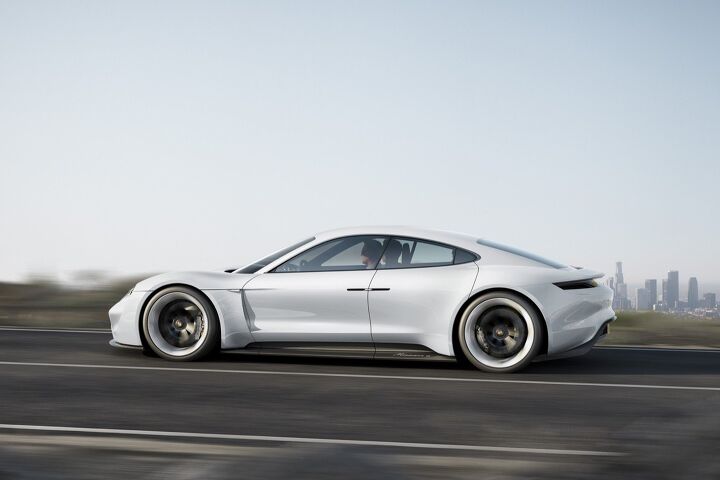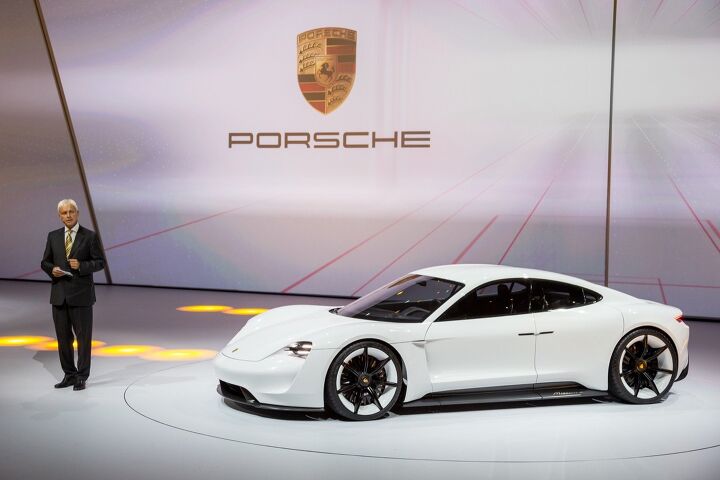Production Porsche Mission E Priced Around $85,000 in 2019; 80-percent Charge Takes 15 Minutes
“It is very close to what you saw two years ago at Frankfurt,” Porsche CEO Oliver Blume says of the forthcoming production version of 2015’s stunning Mission E Concept.
“It will be exciting but a bit different from the concept,” Blume told CAR Magazine at the Frankfurt Motor Show.
That’s for beholders to gauge once the production version of the Mission E is pictured in 2019, when the model arrives exclusively with electric powertrains. Oliver Blume did, however, make clearer commitments relative to the Mission E that will delight Porschephiles and — perhaps — convert Tesla fans.
Right from launch, the Porsche Mission E — likely a 2020 model year vehicle — will be marketed with a 350 kW charge rate that “will be enough for a 400-kilometer range on an 80 percent charge,” Blume says. That’s 250 miles of range from a 15-minute charge. All of this in a car that Porsche claims accelerates from rest to 60 miles per hour in 3.5 seconds and tops 155 mph, a car Porsche couldn’t have developed “so quickly without the 919” — the automaker’s Le Mans-winning hybrid endurance racer.
Porsche’s CEO says the company is in the final engineering phases for the Mission E, a car the company sees as filling the void in between the Panamera and 911. At least to start, the production Mission E — which Porsche calls a “fascinating sports car” — will be positioned alongside its sports car and sedan bookends. It will, says Porsche, be “priced like entry-level Panamera.”
Including delivery, Porsche USA’s entry-level Panamera starts at $86,050. The basic Porsche 911 Carrera is a $92,150 car.
Porsche says the Mission E’s fully charged range will be 300 miles, but the company is considering different power outputs — expect S and GTS models, for example — which will presumably alter the range. The dual-motor format promises all-wheel drive. Different bodystyles are also under consideration.
Presently, the least costly Tesla Model S is the $69,500 rear-wheel drive 75 with 249 miles of range and a 4.3-second 0-60 time. Tesla also markets the $74,500 75D (with slightly more range and all-wheel drive), the $94,000 100D (335-mile range, 0-60 in 4.1), and the $135,000 P100D, which drops range by 20 miles but cuts the 0-60 time to a claimed 2.5 seconds.
At launch, however, faithfulness to 2015’s concept could end up as just as strong a selling point as the Porsche badge or Model S-baiting acceleration figures. Few and far between are cars with enough drama to match the Mission E’s eye-catching design.
[Images: Porsche]
Timothy Cain is a contributing analyst at The Truth About Cars and Autofocus.ca and the founder and former editor of GoodCarBadCar.net. Follow on Twitter @timcaincars and Instagram.
More by Timothy Cain
Latest Car Reviews
Read moreLatest Product Reviews
Read moreRecent Comments
- HotRod Not me personally, but yes - lower prices will dramatically increase the EV's appeal.
- Slavuta "the price isn’t terrible by current EV standards, starting at $47,200"Not terrible for a new Toyota model. But for a Vietnamese no-name, this is terrible.
- Slavuta This is catch22 for me. I would take RAV4 for the powertrain alone. And I wouldn't take it for the same thing. Engines have history of issues and transmission shifts like glass. So, the advantage over hard-working 1.5 is lost.My answer is simple - CX5. This is Japan built, excellent car which has only one shortage - the trunk space.
- Slavuta "Toyota engineers have told us that they intentionally build their powertrains with longevity in mind"Engine is exactly the area where Toyota 4cyl engines had big issues even recently. There was no longevity of any kind. They didn't break, they just consumed so much oil that it was like fueling gasoline and feeding oil every time
- Wjtinfwb Very fortunate so far; the fleet ranges from 2002 to 2023, the most expensive car to maintain we have is our 2020 Acura MDX. One significant issue was taken care of under warranty, otherwise, 6 oil changes at the Acura dealer at $89.95 for full-synthetic and a new set of Michelin Defenders and 4-wheel alignment for 1300. No complaints. a '16 Subaru Crosstrek and '16 Focus ST have each required a new battery, the Ford's was covered under warranty, Subaru's was just under $200. 2 sets of tires on the Focus, 1 set on the Subie. That's it. The Focus has 80k on it and gets synthetic ever 5k at about $90, the Crosstrek is almost identical except I'll run it to 7500 since it's not turbocharged. My '02 V10 Excursion gets one oil change a year, I do it myself for about $30 bucks with Synthetic oil and Motorcraft filter from Wal-Mart for less than $40 bucks. Otherwise it asks for nothing and never has. My new Bronco is still under warranty and has no issues. The local Ford dealer sucks so I do it myself. 6 qts. of full syn, a Motorcraft cartridge filter from Amazon. Total cost about $55 bucks. Takes me 45 minutes. All in I spend about $400/yr. maintaining cars not including tires. The Excursion will likely need some front end work this year, I've set aside a thousand bucks for that. A lot less expensive than when our fleet was smaller but all German.



































Comments
Join the conversation
If that car ends up selling for $85K, I'll eat my hat. . .
Well I am impressed with that charge rate, not sure who's supplying the battery cells for Porsche but if they can really charge that quickly it's going to be impressive. Of course, being able to charge that quickly is mostly helpful if there's really that many high speed charging stations. So that's the part they're really going to have to work on-make sure that high speed CCS chargers get installed along important routes like Tesla's done. I do wonder what Tesla is going to do in response though, they've hinted at a next gen charge rate that would exceed this but I don't think it'll be out by 2019.